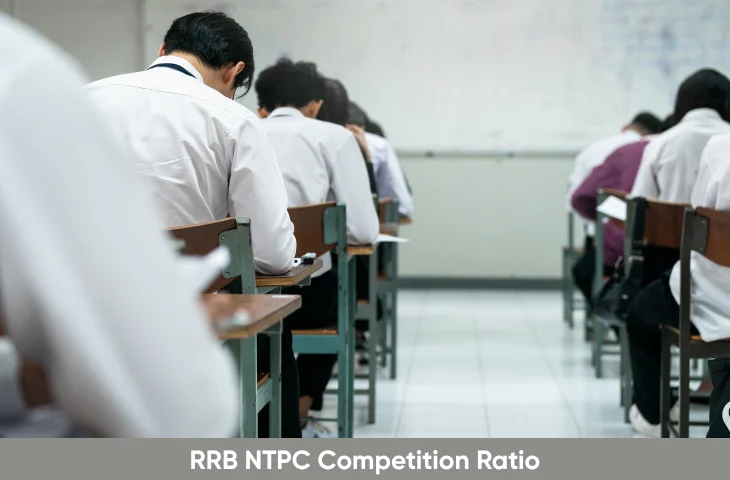RRB NTPC Competition Ratio: The RRB NTPC exam (Railway Recruitment Board Non-Technical Popular Categories) is one of the most sought-after exams in India, attracting lakhs of candidates every year. One key factor that candidates often overlook is the RRB NTPC competition ratio, which varies across zones and directly affects the chances of selection. Understanding the zone-wise competition ratio can help aspirants plan their preparation strategy more effectively and set realistic targets.
What is RRB NTPC Competition Ratio?
The RRB NTPC competition ratio refers to the ratio of candidates who apply for a particular vacancy in a railway zone versus the number of available positions. It essentially indicates how many candidates are competing for a single post in a specific zone.
Formula: Number of Applicants/Number of Vacancies
Importance:
- Helps candidates understand zone-specific competition intensity.
- Assists in predicting normalized cutoff marks.
- Helps prioritize preparation focus for highly competitive zones.
Factors Affecting Zone-Wise Competition
Certain factors affect the zone wise competition ratio in the RRB NTPC exam. Some of them are as follows:
- Vacancy Size: Zones with fewer vacancies see higher competition ratios.
- Regional Preference: Candidates prefer zones closer to home or metro cities.
- Historical Cutoff Trends: Zones with historically lower cutoffs attract more candidates.
- Population Density: Highly populated zones naturally attract more applicants.
Overview of Zone-Wise Competition Ratio
The RRB NTPC exam is conducted across 21 zones. While exact figures vary each year, historical data from NTPC CBT-1 & CBT-2 indicate notable differences in competition ratios:
| Railway Zones | Approximate Vacancies | Approx. Applicants | Competition Ratio | Notes |
| Northern Railway (NR) | 1500 | 6,00,000 | 400:1 | Highly competitive, includes Delhi |
| Western Railway (WR) | 1200 | 5,00,000 | 417:1 | Mumbai region included, high preference |
| Southern Railway (SR) | 1300 | 3,50,000 | 269:1 | Moderate competition, includes Chennai |
| Eastern Railway (ER) | 1100 | 4,50,000 | 409:1 | Kolkata-based posts, high applications |
| North Eastern Railway (NER) | 800 | 1,50,000 | 188:1 | Lower competition, fewer applicants |
| South Central Railway (SCR) | 1000 | 2,50,000 | 250:1 | Moderate competition, Hyderabad included |
| Central Railway (CR) | 950 | 2,00,000 | 211:1 | Includes Mumbai, moderate-to-high competition |
| South Eastern Railway (SER) | 850 | 2,00,000 | 235:1 | Moderate competition |
| North Central Railway (NCR) | 900 | 3,00,000 | 333:1 | Includes Kanpur & Allahabad, higher preference |
| East Coast Railway (ECoR) | 700 | 1,50,000 | 214:1 | Low-to-moderate competition |
| Others (8 zones) | 500–900 each | 1,00,000–2,00,000 | 150–300:1 | Varies by zone |
Observed Trends in RRB NTPC Competition Ratio
As observed, the RRB NTPC Vacancy in the metro zones are highly competitive as compared to other areas. Check out the details below:
- Metro Zones Are Highly Competitive: Zones like Northern, Western, and Eastern Railway have the highest ratios.
- Smaller Zones Offer Better Chances: North Eastern, East Coast, and South Eastern zones have comparatively lower competition ratios.
- Vacancy Distribution Matters: Even a small change in vacancy count significantly affects the ratio.
- Preference for Hometown Zones: Candidates prefer to apply for zones close to their native region.
How Zone-Wise Competition Ratio Impacts Exam Strategy?
The zone wise competition ratio impacts exam strategy in certain ways:
- Targeted Preparation: Candidates aiming for highly competitive zones should focus on achieving higher accuracy and attempting more questions.
- Backup Zones: Apply to zones with lower competition ratios to increase the chance of selection.
- Cutoff Prediction: Understanding competition helps predict normalized cutoffs for each zone.
- Time Management: High-ratio zones may require more rigorous mock tests to ensure top percentile performance.
Tips to Handle High Competition Zones
Given below are some tips to handle the high competition zones:
- Master High-Weightage Topics: Focus on Mathematics, Reasoning, and General Awareness.
- Daily Mock Practice: Simulate exam conditions to improve speed and accuracy.
- Shortcut Techniques: Learn calculation shortcuts for Maths to save time.
- Memory-Based Question Practice: Review previous year questions to understand common patterns.
- Zone Choice Strategy: Consider applying to multiple zones to maximize selection probability.
Summary
The important points of the article are summarized below. Check out the details for a quick overview:
- RRB NTPC competition ratio indicates the number of applicants per vacancy in each railway zone.
- Metro zones like NR, WR, and ER have extremely high competition ratios (above 400:1).
- Smaller or less preferred zones like NER and ECoR have lower competition ratios, offering better chances.
- Knowledge of zone-wise competition ratio helps in targeted preparation, strategic zone selection, and cutoff prediction.
- Prioritizing high-yield topics, practicing mocks, and reviewing memory-based questions improves chances in high-competition zones.
Understanding the RRB NTPC competition ratio is vital for aspirants to plan a smart preparation strategy. Candidates can use zone-wise insights to choose target zones wisely, optimize study time, and maximize scores in both CBT 1 and CBT 2. With focused preparation and strategic planning, aspirants can navigate high-competition zones effectively and improve their chances of selection in the RRB NTPC exam.
FAQs
The RRB NTPC competition ratio refers to the number of applicants competing for a single vacancy in a particular railway zone. It is calculated by dividing the total number of applicants by the total vacancies in that zone.
Historically, metro zones like Northern Railway (NR), Western Railway (WR), and Eastern Railway (ER) have the highest competition ratios, often exceeding 400:1 due to high population density and aspirant preference.
Higher competition ratios usually result in higher normalized cutoff marks because more candidates are competing for the same number of vacancies. Conversely, lower competition zones often have slightly lower cutoffs.
Yes, applying to zones with lower competition ratios, such as North Eastern Railway (NER) or East Coast Railway (ECoR), can improve your chances of selection. However, candidates should also consider personal preferences and location convenience.
Understanding zone-wise competition ratios allows candidates to:
Prioritize highly competitive zones for more focused preparation.
Plan backup options in lower-competition zones.
Set realistic target scores and cutoffs.
Strategically manage time and practice mock tests for top performance.
- RRB NTPC Medical Test 2025, Check Post Wise Medical Criteria
- RRB NTPC Undergraduate Notification 2025, Apply for 3058 Posts
- RRB NTPC परीक्षा के लिए स्टेटिक जीके टॉपिक, यहां जानिए सभी टॉपिक्स
- RRB NTPC vs SSC CGL vs IBPS Clerk, Check Complete Analysis
- Importance of RRB NTPC Psycho Test, Know the Details of Test
- रेलवे परीक्षा की तैयारी करें, सारी जानकारी यहां देखें

Hello! This is Arijit Dutta. I am a skilled Content Writer at Oliveboard with nearly 3+ years of experience in crafting engaging, informative, and exam-focused content for the Railways Domain. With a strong command of language and a keen understanding of learner needs, I contribute significantly to Oliveboard’s mission of delivering high-quality educational resources. Passionate about clear communication and continuous learning, I consistently create content that helps government job aspirants achieve their goals. Outside of work, I enjoy playing cricket and listening to music, which helps me stay balanced and creative in my professional journey.
